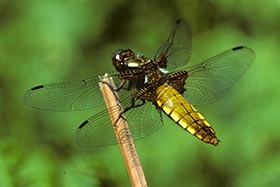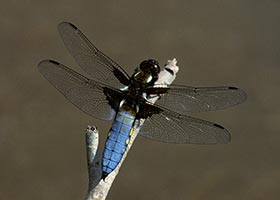Broad-bodied Chaser (Libellula depressa)
When: Early May to early August
How many: Relatively widespread, but rarely abundant

Often the first 'large' dragonflies of the year to be seen on the wing in the New Forest, Broad-bodied Chasers are present from May until August, but tend to be more conspicuous during the early and middle parts of their flight period.
Females are a striking golden yellow-brown colour with lighter yellow markings along the edge of their fattened abdomens. Males - pale, powder blue creatures with similar yellow abdominal markings - are aggressive, highly territorial insects that can often be seen chasing away rivals and even dragonflies of other species.

Wingspan is around 7.5 centimetres, whilst length is 4.5 centimetres. As the name suggests, both sexes are noticeably 'broad-bodied'. Perches - sticks protruding from the water, for example, or fallen branches in the water - are regularly used, so-much-so that excellent views can be obtained by simply identifying a favoured perch and then sitting and waiting for the insect to return.
(Four-spotted Chasers also occur in the New Forest, but tend to be less frequently seen than their broad-bodied cousins, have predominantly dark brown, relatively slender abdomens and two dark spots - rather than one - on each wing. Scarce Chasers are also present, but are infrequently seen - mature individuals are superficially similar in colour and markings to Broad-bodied Chasers, but are marginally smaller and have comparatively slender abdomens without yellow edge markings).
References:
A Guide to the Dragonflies of Great Britain: Dan Powell
Dragonflies and Damselflies of Britain and Northern Europe: Bob Gibbons
More links
Other related links
Search this site

Sadly, 58 animals were killed - 35 ponies, 13 cows, 8 donkeys and 2 sheep, whilst a further 32 were injured - 3 pigs, 9 donkeys, 11 cows and 9 ponies.
(Forty-three accidents occurred in daylight, 15 at twilight and 101 in the dark. Twenty-seven accidents were not reported by the driver involved).
Here's just one horrific example - Three donkeys killed in collision with van at notorious New Forest blackspot (Advertiser and Times)

